Book contents
- Frontmatter
- Contents
- Contributors
- Series Foreword
- Foreword
- Acknowledgments
- Section I Games as Designed Experience
- 1 Introduction to Section I
- 2 Designed Cultures
- 3 Theme Is Not Meaning
- 4 Our Cheatin’ Hearts
- 5 Playing the Odds
- 6 Nurturing Lateral Leaps in Game Design
- 7 Uncharted 2: Among Thieves – How to Become a Hero
- 8 Interview with Harmonix
- 9 Yomi
- Section II Games as Emergent Culture
- Section III Games as Twenty-First-Century Curriculum
- Index
- References
7 - Uncharted 2: Among Thieves – How to Become a Hero
Published online by Cambridge University Press: 05 August 2012
- Frontmatter
- Contents
- Contributors
- Series Foreword
- Foreword
- Acknowledgments
- Section I Games as Designed Experience
- 1 Introduction to Section I
- 2 Designed Cultures
- 3 Theme Is Not Meaning
- 4 Our Cheatin’ Hearts
- 5 Playing the Odds
- 6 Nurturing Lateral Leaps in Game Design
- 7 Uncharted 2: Among Thieves – How to Become a Hero
- 8 Interview with Harmonix
- 9 Yomi
- Section II Games as Emergent Culture
- Section III Games as Twenty-First-Century Curriculum
- Index
- References
Summary
With this chapter, we’re going to unpack how the design of a game (Uncharted 2: Among Thieves) can offer players the chance to explore and learn all the possibilities within the playing experience. In other words, a good game can teach you how to play it through the very act of playing it. And players can develop a literacy of games as they learn through the playing of a variety of games.
In Well Played 1.0, a book I edited, contributors performed in-depth close readings of video games to parse out the various meanings to be found in the experience of playing a game and how it can be well played.
To clarify, we used the term well played in two senses. On the one hand, well played is to games as well read is to books. Thus a person who reads books a lot is “well read” and a person who plays games a lot is “well played.” On the other hand, well played as in well done. Thus a hand of poker can be “well played” by a person, and a game can be “well played” by the development team.
With this in mind, Richard Lemarchand (lead game designer at Naughty Dog and Co-Lead Game Designer of Uncharted 2: Among Thieves) and I are going to explore the making and playing of the game. We’re going to analyze sequences in the game in detail in order to illustrate and interpret how the various components of a game can come together to create a fulfilling playing experience unique to this medium. With this chapter, I wrote a complete first pass, unpacking my game-playing experience (which included some discussions with Richard). Richard then added in his thoughts and responses to my analysis, to which I, in turn, replied. Therefore, the bulk of this chapter is from my perspective, but we’ve called out specii c comments from Richard and my replies. Throughout, we’ve tried to capture the range of dialogue we’ve had around and about the game.
- Type
- Chapter
- Information
- Games, Learning, and SocietyLearning and Meaning in the Digital Age, pp. 75 - 107Publisher: Cambridge University PressPrint publication year: 2012
References
- 2
- Cited by



